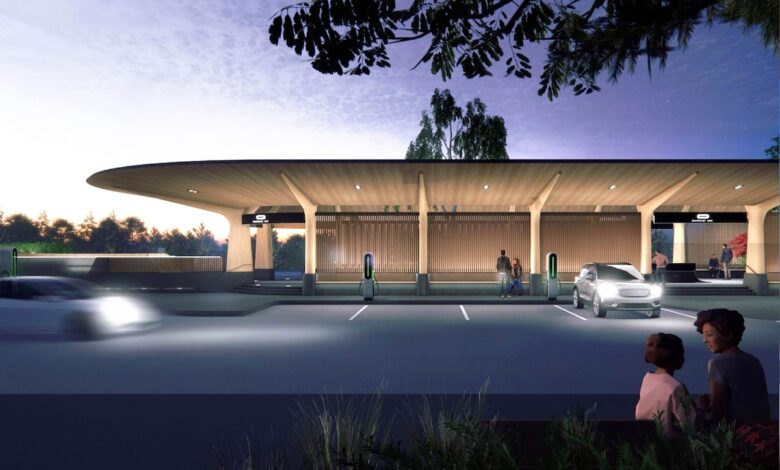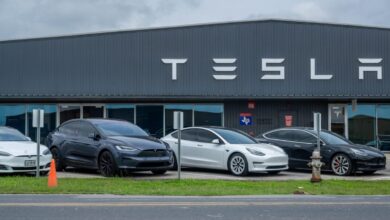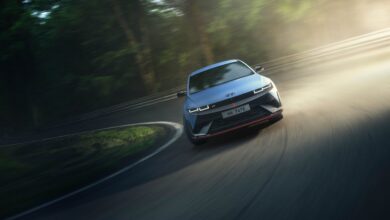What will the EV charging station of the future look like?

Waypoint One, the top Canadian entry in an international design competition of electric-vehicle charging stations, shows a sustainable fuelling site that provides a charging hub and rest areas inspired by the natural environment.Sean Solowski Architect
While Canada is making plans to switch to all-electric vehicles by 2035, Gary Williams is making plans for what to do with his gas stations.
“We’ve been considering putting solar panels on our stations to provide the energy for electric vehicle [EV] charging, but we’re moving cautiously,” says Mr. Williams, co-owner and brand ambassador for Gen7 Fuels, a chain of six Indigenous-owned fuel stations and convenience stores in Ontario and British Columbia.
Gen7′s name attests to the company’s belief that enterprises should consider the needs of seven generations into the future, he says. “But when it comes to electric charging, I don’t think everyone has thought it through enough yet,” says Mr. Williams, who has also served as Chief of Curve Lake First Nation in Ontario’s Kawartha Lakes area.
“It’s a bit of a chicken-and-egg situation right now. People in vehicles, energy, property and government are looking at all the challenges,” says Ilana Weitzman, vice-president for strategic initiatives and clean transportation at Electric Autonomy Canada, a media and events company focused on the country’s transition to electric vehicles, autonomous transportation and new mobility services.
Before we move too fast, we need a better electricity infrastructure for the power all these EVs are going to need, and we need to see people buying these vehicles.
— Gary Williams, co-owner and brand ambassador, Gen7 Fuels
While Canadians are buying electric vehicles, most are still buying cars that run on gas. According to Statistics Canada, EVs accounted for just 3 per cent of light vehicle sales in 2022, up from 2.3 per cent a year earlier. The increase in purchases may seem slow, but the technology for charging EVs, is changing constantly.
“How much charging infrastructure do we need for the number of [electric] vehicles on the road? What kind of chargers? The needs are different all the time,” Ms. Weitzman says.
Last December, the federal government announced that all auto manufacturers and importers must produce cars that meet zero-emission standards for greenhouse gas emissions by 2035. The zero-emission targets are to be phased in starting with 2026 models.
Gas station owners are making overhauls to their properties to add EV charging capabilities. In Canada, an estimated 200,000 chargers will be needed by 2030.Sean Solowski Architect
Used gas-powered vehicles will remain on the road after 2035, but in the meantime the auto industry in Ontario and the United States is investing heavily in EV and battery production.
In May, Electric Autonomy showcased futuristic designs for charging stations drawn up by more than 100 architects and designers around the world.
The design competition was held in partnership with Parkland Corp., an international fuel distributor that operates gas stations and convenience outlets in 26 countries, including some 2,000 outlets in Canada. Parkland plans to build a prototype of the first prize winner, by Scottish architect James Silvester, at a site in British Columbia.
The top Canadian entry is an oblong-shaped series of charging bays. The design includes a micro-grid to produce distributed power, with on-site solar panels augmenting electricity from the grid.
“I grew up going on road trips with my parents and I loved the roadside rest stops we’d pull into,” says Toronto architect Sean Solowski, who designed the entry.
“I designed this station to offer stillness and calm. But the building also takes inspiration from the instrument panel on a car,” he says.
While owners like Mr. Williams remain cautious, other companies have been adding EV facilities. In December, 2019, Petro-Canada completed its trademarked Electric Highway, the first coast-to-coast network of ultra-fast EV chargers.
In a progress report the company conceded that it’s not easy to bring in new charging technology when the technology itself is changing constantly.
“Our immediate priorities focus on refining the reliability of our chargers,” Petro-Canada said in the report. Weitzman adds that many EV drivers still have “range anxiety;” they worry about whether they will make it to the nearest charger.
By 2022 there were approximately 22,000 EV charging stations across Canada, not just at gas stations. Property developers are including EV chargers in their parking lots and garages, in many cases required under local zoning and building permit rules.
The Canada Infrastructure Bank launched a $500-million program to add another 50,000 EV chargers by 2025, with the federal government forecasting that Canada will need 200,000 chargers by 2030. “We are in the early stages of financing,” says Ross Marowits, spokesperson for the Crown-owned bank.
An oblong-shaped series of charging bays would have a microgrid to produce distributed power, with on-site solar panels augmenting electricity from the grid.Sean Solowski Architect
Another challenge to rolling out EV chargers is that there is not yet a charger that fits every EV, Ms. Weitzman says. “We’re moving toward a North American standard but we’re not quite there yet. It’s like the VHS versus the Betamax loop we had with videos.”
There’s also the time it takes to charge. If drivers need to spend 15 minutes or more, they will want something to do while they’re waiting, Ms. Weitzman says.
“You can still get washer fluid, grab a snack and wash up. But EV station designs don’t necessarily have to look like gas stations,” she says.
You don’t even need to have a station to have a charger, she adds. “People already charge their cars at home, at work, at parking spaces,” she says. It’s possible offsite charging may do to stations what cellphones did to phone booths – make them unnecessary.
“It could happen,” Ms. Weitzman says.
But station operators will step up to make sure this doesn’t happen, says Scott Sharabura, vice-president, of electric vehicle charging at Parkland.
“It’s technically possible to have charging where you just swipe your credit card and don’t interact with a human, but we won’t do that,” he says.
“We serve a million customers every day across Canada and in the U.S. and the Caribbean, so we’ve spent a lot of time and effort to understand what people do in the time they refuel,” he told the Electric Autonomy gathering.
“Of course, we’re thinking a lot about the [EV] plug but we’re also thinking about everything else that people want and need when they pull in.”
Ultimately, says Mr. Williams, “it’s the market that’s going to decide what happens with EVs.”
“Before we move too fast, we need a better electricity infrastructure for the power all these EVs are going to need, and we need to see people buying these vehicles,” he says.



